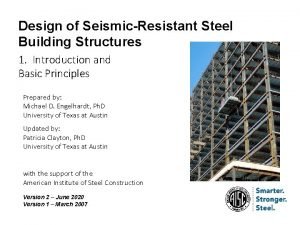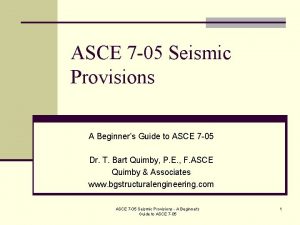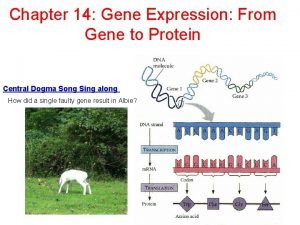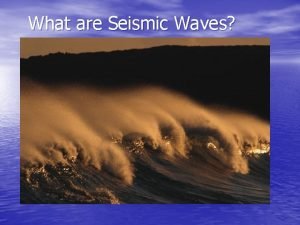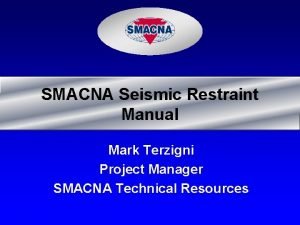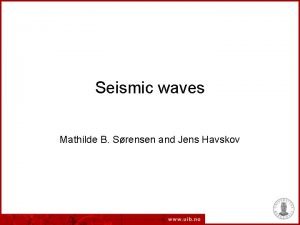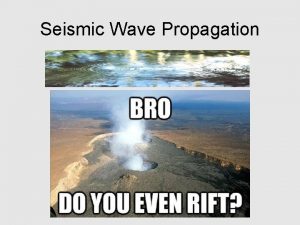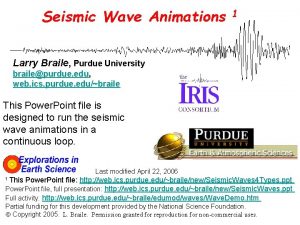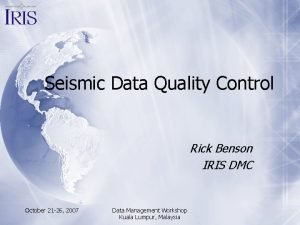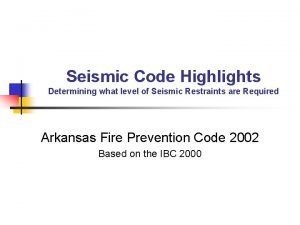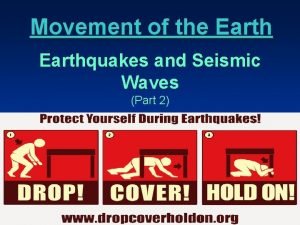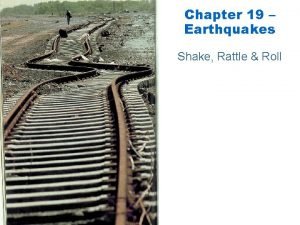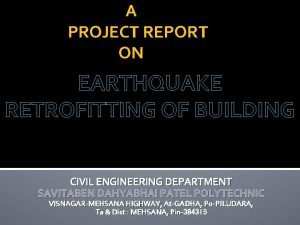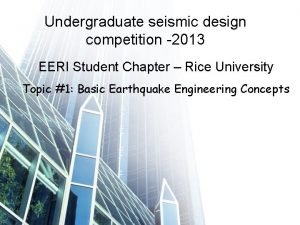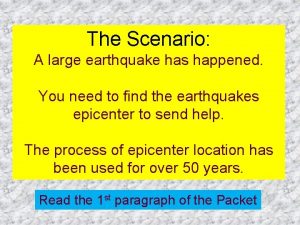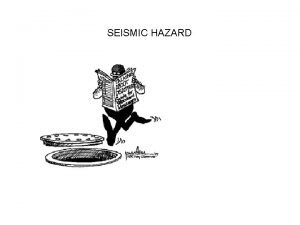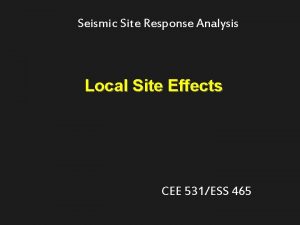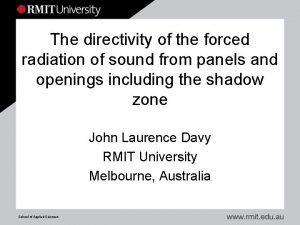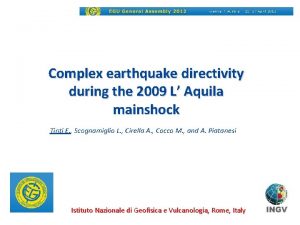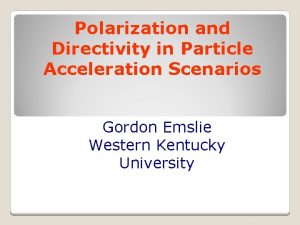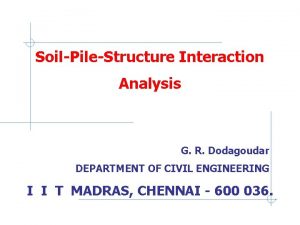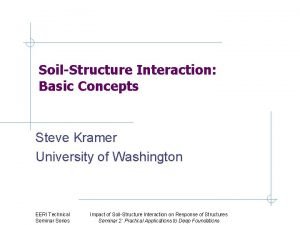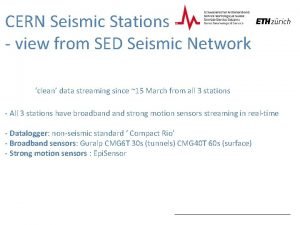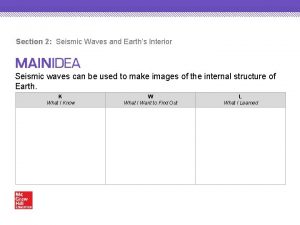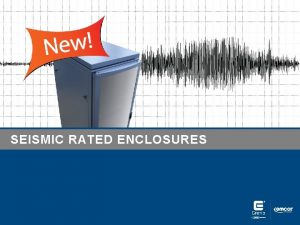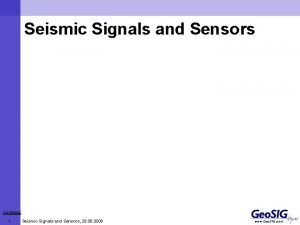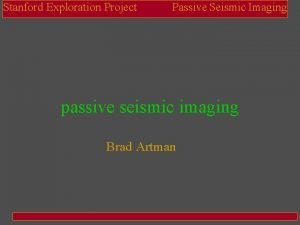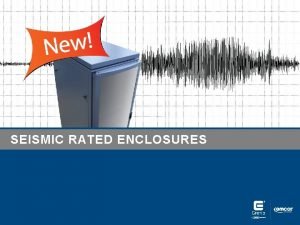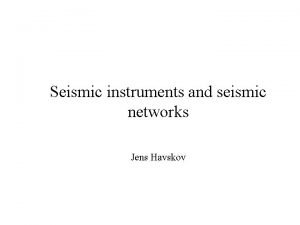DETECTION OF DIRECTIVITY IN SEISMIC SITE RESPONSE FROM


























- Slides: 26

DETECTION OF DIRECTIVITY IN SEISMIC SITE RESPONSE FROM MICROTREMOR SPECTRAL ANALYSIS V. Del Gaudio 1, S. Coccia 1, J. Wasowski 2, M. R. Gallipoli 3, and M. Mucciarelli 4 1. Dipartimento di Geologia e Geofisica, Universit`a degli Studi di Bari, Italy 2. Istituto di Ricerca per la Protezione Idrogeologica, Consiglio Nazionale delle Ricerche, Bari, Italy 3. Istituto di Metodologie per le Analisi Ambientale, Consiglio Nazionale delle Ricerche, Tito Scalo, Potenza, Italy 4. Dipartimento di Strutture, Geotecnica, Geologia Applicata all’Ingegneria, Universit`a degli Studi della Basilicata, Potenza, Italy 報告 者:林子翔 指導 教授:李錫堤 報告 日期: 06/09 1

Research Motivation INTRODUCTION Recent observations have shown that slope response to seismic shaking can be characterized by directional variations of a factor of 2– 3 or larger, with maxima oriented along local topography features (e. g. maximum slope direction). This phenomenon appears influenced by slope material properties and has occasionally been detected on landslideprone slopes, where a down-slope directed amplification could enhance susceptibility to seismically-induced landsliding. We tested the applicability of a method commonly used to evaluate site resonance properties (Horizontal to Vertical Noise Ratio – HVNR or Nakamura’s method ) as reconnaissance technique for the identification of site response directivity.

Research Motivation PREVIOUS WORK The analysis presented by Del Gaudio and Wasowski (2007) suggests that these phenomena are not caused by a purely topographic effect. Indeed, a fundamental role seems to be played by anisotropies in slope material properties, which, in different settings, can be either induced by factors controlling also the topographic relief (e. g. tectonics) or directly controlled by the topography (e. g. as effect of gravity-driven mass movements). However, until now, the limited amount of observational data has not allowed a thorough understanding of factors controlling directional amplification and the definition of practical recognition criteria

Research Method SITE EFFECT EVALUATIONS site effect evaluations by reference site method and nonreference sitemethod HSS=Horizontal Spectrum of Sedimentary site Reference site method HSR=Horizontal Spectrumof Reference site HNS=Horizontal Noise of Sedimentary site HNR=Horizontal Noise of Reference site Borcherdt(1970) HNS=Horizontal Noise of Sedimentary site Non-reference sitemethod VNS=Vertical Noise of Sedimentary site HSS=Horizontal Spectrum of Sedimentary site VSS=Vertical Spectrum of Sedimentary site Nakamura(1989) Lermo and Chávez-García (1993)

Research Method ABOUT HVNR The HVNR technique, despite its somewhat unclear theoretical bases (see Bonnefoy-Claudet et al. , 2006 a), has been diffusely applied in microzonation studies, mainly because peaks in the H/V spectral ratios have proved to be an effective indicator of the resonance frequency of low-impedance surface layers. The technique remains popular even though the reliability of the associated estimate of the amplification factor is deemed questionable (Bonnefoy-Claudet et al. , 2006 b).

Study Area ORFENTO AND ORTA RIVER VALLEYS ROMA high relief active river erosion strong permeability contrasts between different lithologies abundant rainfall c lose to active seismogenic structures a case triggered by an event that was quite far away (with epicentral distance more than 100 km)

Study Area ACCELEROMETRIC NETWORK Etna Tromino = accelerometric stations. = microseismic noise measurements. 地質年代(百萬年) 岩性代號 英文 岩性 第四紀(1. 8 -today) Bq Quaternary limestone megabreccias 石灰質火山角礫岩 第四紀全新世(0. 01 -today) Sqh Quaternary and Holocene soils (colluvium and artificial ground) 土壤(崩積層與人 地面) 第三紀上新世(5. 3 -1. 8) Mp Pliocene mudstones 泥岩 第三紀中新世晚期(7. 246– 5. 332 ) Me Messinian sandy-silty deposits with carbonate breccia 粉砂沉積物混和碳酸鹽質角礫岩 第三紀中新世(23 -5. 3) Lm Miocene 石灰岩 未確認年代 L(m) limestones of uncertain Miocene age 石灰岩 7

Study Area GEOLOGIC PROFILES Car 5 Car 1 5 Car 3 Car 4 Car 2

Study Area HVNR MEASUREMENTS

WEAK MOTION DATA 2002 -2008 10

Data Analysis CAR 1 VS CAR 2 & CAR 4 VS CAR 3 11

Data Analysis POLAR DIAGRAMS OF NORMALIZED ARIAS INTENSITY Max, 0. 90;min, 0. 83 Max, 0. 99, 260° Min, 0. 55, 170° Max, 0. 96, 290° min, 0. 33, 200° 12 Max, 0. 89;min, 0. 59

Data Analysis POLAR DIAGRAMS OF HVSR Horizontal - to Vertical Spectral Ratio (HVSR) from seismic “weak motion” data until 2008 13

HVNR RESULTS 14

Data Analysis POLAR DIAGRAMS OF HVNR Tromino Horizontal - to Vertical Noise Ratio (HVNR) from microtremor recordings 15

Data Analysis HVSR VS HVNR ↓ Mm. Q > 1. 5 以 作 為 門 檻 值 了 解 有 無 方 向 性 16 HVM: at the frequency the maximum spectral ratio of H/V HVm: at the frequency the minimum spectral ratio of H/V

Data Analysis HVSR VS HVNR 17

Data Analysis POLAR DIAGRAMS OF HVNR Etna Horizontal - to Vertical Noise Ratio (HVNR) from microtremor recordings 13. 1 14. 7 18

Data Analysis INFLUENCE OF INSTRUMENTAL PROPERTIES Etna/Tromino 13 19

Data Analysis POLAR DIAGRAMS OF HVNR 20

Data Analysis HVSR VS HVNR 2. 4 90 5. 3 1. 7 21 HVM: at the frequency the maximum spectral ratio of H/V HVm: at the frequency the minimum spectral ratio of H/V

Discussion and Conclusions PROVISIONAL CRITERIA FOR SITE RESPONSE DIRECTIVITY IDENTIFICATION FROM HVNR 1. Peaks with significant H/V spectral ratio values (not less than 2) having a significant directivity (maximum/minimum quotient larger than 1. 5) should be identified in the azimuthal distribution of HVNR values 2. If only one peak with a significant directivity is found , repeated measurements have to be performed at different hours and week days, to rule out the possibility that the single directional maximum is due to a source of polarised noise and thus may not reflect site properties 3. Major directional peaks should have similar directions (within an azimuth interval of 20– 30); otherwise differently oriented pronounced peaks could reflect the coexistence of different sources of polarised noise at different azimuths.

Discussion and Conclusions 1. several directional spectral peaks can be found at different frequencies along similar directions. 2. The calculation of horizontal to vertical spectral ratios derived from seismic events (HVSR) or microtremor measurements (HVNR) can provide quite variable peak frequencies in relation to the signal-to-noise ratio characterizing recordings in different frequency bands. 3. under the conditions of site response complexity typical of slopes with both topographic and lithostratigraphic amplification, HVNR and HVSR measurements alone cannot provide a complete and reliable identification of resonance frequencies and amplification factors.

The End 24


 Hot site cold site warm site disaster recovery
Hot site cold site warm site disaster recovery Aisc
Aisc Asce 7 05 seismic
Asce 7 05 seismic Natural response and forced response
Natural response and forced response Natural and forced response
Natural and forced response Primary immune response and secondary immune response
Primary immune response and secondary immune response One gene one enzyme hypothesis
One gene one enzyme hypothesis Site inventory landscape architecture
Site inventory landscape architecture Untangle openvpn setup
Untangle openvpn setup Surface wave
Surface wave Seismic restraint manual
Seismic restraint manual Thereforw
Thereforw Seismic waves
Seismic waves Seismic waves
Seismic waves Seismic waves animation
Seismic waves animation Seismic quality control
Seismic quality control Seismic design categories
Seismic design categories Seismic cable connector factories
Seismic cable connector factories Sac seismic
Sac seismic Seismic wave types
Seismic wave types Surface waves and body waves
Surface waves and body waves 1997 uniform building code seismic zone map
1997 uniform building code seismic zone map Deterministic seismic hazard analysis
Deterministic seismic hazard analysis The san andreas fault a result of horizontal shear is a
The san andreas fault a result of horizontal shear is a Retrofitting project report
Retrofitting project report Eeri seismic design competition
Eeri seismic design competition Elko, nv seismic station s-p interval = seconds
Elko, nv seismic station s-p interval = seconds

